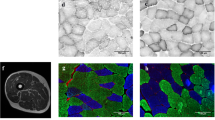Summary
Forty-eight sedentary and 39 quite active or well-trained men participated in this study. Muscle biopsy samples were taken from the vastus lateralis for the determination of fiber type composition (I, IIa, IIb), fiber type area, and assay of the following enzymes: malate dehydrogenase (MDH), 3-hydroxyacyl CoA dehydrogenase (HADH) and oxoglutarate dehydrogenase (OGDH). Maximal oxygen uptake (\(\dot V_{{\text{O}}_{{\text{2max}}} }\)) was determined with a progressive cycle ergometer test, while endurance performance or maximal aerobic capacity (MAC) was defined as the total work output during a 90-min cycle ergometer test. Correlation analysis revealed no evidence of association between fiber type composition and \(\dot V_{{\text{O}}_{{\text{2max}}} }\) kg−1 or MAC kg−1 in sedentary subjects, while active men exhibited significant correlation between % type I (r=0.52), % type IIb (r=−0.31) and \(\dot V_{{\text{O}}_{{\text{2max}}} }\) kg−1. Enzyme activities were not significantly correlated with MAC kg−1 and \(\dot V_{{\text{O}}_{{\text{2max}}} }\) kg−1 in sedentary men while active men exhibited significant correlation for the three enzymes (0.37≤r≤0.51) with \(\dot V_{{\text{O}}_{{\text{2max}}} }\) kg−1. These results show that the contribution of muscle fiber type and enzyme activities to aerobic performance may be inflated from a statistiscal point of view by the training status heterogeneity of subjects. They also suggest that variation in these muscle characteristics does not account for the individual differences in aerobic performance of subjects who have never trained before. Therefore, the assessment of muscle characteristics is not as useful as originally thought for the detection of individuals with a high potential for endurance performance among untrained subjects.
Similar content being viewed by others
References
Bergh U, Thorstensson A, Sjodin B, Hulten B, Piehl K, Karlsson J (1978) Maximal oxygen uptake and muscle fiber types in trained and untrained humans. Med Sci Sports 10:151–154
Blomquist G, Saltin B (1983) Cardiovascular adaptations to physical training. Ann Rev Physiol 45:169–189
Booth FW, Narahara KA (1974) Vastus lateralis cytocrome oxidase activity and its relationships to maximal oxygen consumption in man. Pflügers Arch 349:319–324
Boulay MR, Hamel P, Simoneau JA, Lortie G, Prud'Homme D, Bouchard C (1984) A test of aerobic capacity: description and reliability. Can J Appl Sport Sci 9:122–126
Campbell CJ, Bonen A, Kirby RL, Belcastro AN (1979) Muscle fiber composition and performance capacities of women. Med Sci Sports 11:260–265
Costill DL, Daniels J, Evans W, Fink W, Krahenbuhl G, Saltin B (1976) Skeletal muscle enzymes and fiber composition in male and female track athletes. J. Appl Physiol 40:149–154
Després JP, Bouchard C, Savard R, Tremblay A, Marcotte M, Thériault G (1984) The effect of a 20-week endurance training program on adipose-tissue morphology and lipolysis in men and women. Metabolism 33:235–239
Evans WJ, Phinney SD, Young VR (1982) Suction applied to a muscle biopsy maximizes sample size. Med Sci Sports Exercise 14:101–102
Farrell PA, Wilmore JH, Coyle EF, Billing JE, Costill DL (1979) Plasma lactate accumulation and distance running performance. Med Sci Sports 11:338–344
Foster C, Costill DL, Daniels JT, Fink WJ (1978) Skeletal muscle enzyme activity, fiber composition and \(\dot V_{{\text{O}}_{{\text{2max}}} }\) in relation to distance running performance. Eur J Appl Physiol 39:73–80
Gollnick PD, Armstrong RB, Saltin B, Saubert CW IV, Shepherd RR (1973) Effect of training on enzyme activity and fiber composition of human skeletal muscle. J Appl Physiol 34:107–111
Gregor RJ, Edgerton VR, Rozenek KR, Castelman KR (1981) Skeletal muscle properties and performance in elite female track athletes. Eur J Appl Physiol 47:355–364
Ivy JL, Costill DL, Maxwell BD (1980) Skeletal muscle determinants of maximum aerobic power in man. Eur J Appl Physiol 44:1–8
Karlsson J (1979) Localized muscular fatigue: role of muscle metabolism and substrate depletion. In: Hutton RS, Miller DI (eds) Exercise and sport sciences reviews, vol 7. Franklin Institute Press, USA, pp 1–42
Kiessling KH, Pilstrom L, Bylund AC, Saltin B (1974) Enzyme activities and morphology in skeletal muscle of middle-aged man after training. Scand J Lab Clin Invest 33:63–69
Komi PV, Sjodin B, Wallestein R, Karlsson J (1981) Muscle metabolism, lactate breaking point, and biochemical features of endurance running. Int J Sports Med 2:148–153
Lexell J, Henriksson-Larsen K, Sjostrom M (1983) Distribution of different fiber types in human skeletal muscle. 2. A study of cross-sections of whole m. vastus lateralis. Acta Physiol Scand 117:115–122
Lortie G, Simoneau JA, Hamel P, Boulay MR, Landry F, Bouchard C (1984) Responses of maximal aerobic power and capacity to aerobic training. Int J Sports Med 5:232–236
Lowry PH, Passoneau JV (1972) A flexible system of enzymatic analysis. Academic Press, New York
Mabuchi K, Sreter FA (1980) Actomyosin ATPase. II. Fiber typing by histochemical ATPase reaction. Muscle Nerve 3:233–239
Prud'Homme D, Bouchard C, Leblanc C, Landry F, Lortie G, Boulay MR (1984) Reliability of assessments of ventilatory thresholds. J Sports Sci 2:13–24
Rusko H, Havu M, Karvinen E (1978) Aerobic performance capacity in athletes. Eur J Appl Physiol 38:151–159
Rusko H, Rahkila P, Karvinen E (1980) Anaerobic threshold, skeletal muscle enzymes and fiber composition in young female cross-country skiers. Acta Physiol Scand 108:263–268
Rusko H, Rahkila P (1982) Maximum oxygen uptake, anaerobic threshold, and skeletal muscle enzymes in male athletes. In: Komi PV (ed) Exercise and sport biology. Human Kinetics Publishers, Illinois, pp 68–75
Saltin B, Rowell LB (1980) Functional adaptation to physical activity and inactivity. Fed Proc 39:1506–1513
Schele R, Kaiser P (1982) Running performance and muscle fiber types. In: Komi PV (ed) Exercise and sport biology. Human Kinetics Publishers, Illinois, pp 84–89
Simoneau JA, Lortie G, Boulay MR, Thibault MC, Thériault G, Bouchard C (1985) Skeletal muscle histochemical and biochemical characteristics in sedentary male and female subjects. Can J Physiol Pharmacol 63:30–35
Tesch P, Daniels WL, Sharp DS (1982) Lactate accumulation in muscle and blood during submaximal exercise. Acta Physiol Scand 114:441–446
Author information
Authors and Affiliations
Rights and permissions
About this article
Cite this article
Lortie, G., Simoneau, J.A., Hamel, P. et al. Relationships between skeletal muscle characteristics and aerobic performance in sedentary and active subjects. Europ. J. Appl. Physiol. 54, 471–475 (1985). https://doi.org/10.1007/BF00422954
Accepted:
Issue Date:
DOI: https://doi.org/10.1007/BF00422954




